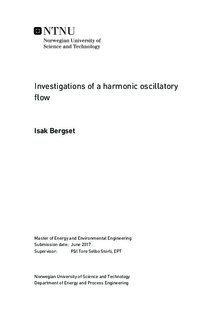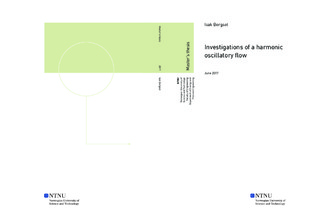| dc.description.abstract | Power companies are on a daily basis making operational strategies to operate power plants in an efficient and good way. To do this must all impacts and challenges with influence be comprised in the analytical work. In a hydropower plant, one of these challenges is related to the estimation of friction impact from dynamics generated after regulating the water flow in the conduit. Usually are power plants constructed to operate at specific flow conditions, such operation condition may nowadays be difficult to maintain or not desirable as price and demand in the power network are always changing. To operate with economic advantage, is it thus important to find the optimal production that corresponds to the optimal combination of price and demand. Hence, the plants has to be regulated. Similar experience occur at some large hydropower plants as they have the responsibility for maintaining the stability of the network frequency by balancing the power production against consumption. Regulation introduce as mention the system to harmonic oscillatory flow, which further presents the challenge of friction modeling. The frictional effect may be difficult to foresee, as the knowledge on the frictional response is undesirably low. Economic losses and expected production are thus hard to estimate. It is thus of interest to purpose a model that can estimate the losses in a manageable way, not requiring too much computational power.
In hydropower plants are one of the generated dynamics called mass oscillations, where the water mass is oscillating between two free surfaces, the surface of the upper reservoir and the surge shaft. There are today few simple models suited to predicting these oscillations. The existing models require a lot of computational power, making them unfit for power companies to use in their daily work. This challenge is one of the main motivation for this thesis, and will thus be the subject of interest to investigate closer.
In the early phase of this thesis was a paper written on the work presented in a project work made by the author in the autumn of 2016 [1], and additionally the planed work of this thesis. The paper was presented at the 7th International symposium on Current Research in Hydraulic Turbines (CRHT-VII) at Kathmandu University in April 2017 and is attached in Appendix H.
The thesis starts with presenting fundamental theory and existing literature on the subject of conduit flow, friction modeling and flow dynamics in hydropower plants. Further, is the experimental test described with laboratory facilities and supported preliminary work. The thesis provides with knowledge and experience on frictional losses through five test cases, which is tested in the established dynamic test rig. The test results are compared against simulations. Four transient friction models are tested, the Quasi-steady model, the model by Ogawa et al., the model by Vitkovsky and the idea of the one-term friction model. The simulation approach for all models is described in detail before results are presented and further discussed.
In the preliminary work was a dynamic test rig for measurements on harmonic oscillatory flow designed, where necessary instruments, sensors and components are installed. Four static pressure transducers and one electromagnetic flowmeter respectively measure pressure and flow rate. One of the pressure probes was located in the surge shaft to measure the water fluctuation. Five meters downstream the upper tank is the EMF located, giving the flow rate and mean velocity. All sensors installed are located at preferred locations, satisfying fully developed flow. Additionally, a test section is established, facilitated for water flow visualization with particle image velocimetry. The dynamic test rig performed well, running with both the traditional surge shaft and the siphon system. Test results from laboratory measurement showed good correspondence on dynamic transient theory and how the dynamics are expected to propagate.
Unsteady flow conditions introduced the fluid to additional friction, where acceleration, deceleration and zero average velocity was present. Simulation results from different models showed large variety in performance. The change in velocity seems to be the main parameter affecting the performance of the diverse modeling results. Performance showed strong relation to how each model was implementing the velocity. Flow acceleration and zero average velocity in the turnings of the oscillations seems to be the main challenges of friction modeling. The new "one-term" model shows a positive trend by providing extra friction in relation to the original Darcy-Weisbach equation under acceleration and deceleration, which correspond to measurement results.
The thesis will describe the challenges closer and evaluate the models in more detail, and thus positively contribute to increasing the knowledge on the subject. | |

